The WSL has had many fiercely-contested derbies over the years, but the Second City derby has never taken place. This weekend saw the first edition of this rivalry occur between Aston Villa Women and Birmingham City Women at Villa Park. This tactical analysis will look at the tactics that both sides used to try and beat the other, both in defensive and attacking phases, as well as how tactical changes helped to swing the game in Birmingham’s favour in the second half.
Lineups

Aston Villa Women made just one change from the team that beat Brighton and Hove Albion Women last weekend, with defender Natalie Haigh moving to the bench. Experienced player Anita Asante slotted into the defence in her place, having played in midfield against Brighton, with captain Marisa Ewers coming off the bench and into the midfield to fill the hole. Scotland midfielder Chloe Arthur started against her former side, having left Birmingham to join Aston Villa over the summer, whilst the front three of Denmark striker Stine Larsen, Shania Hayles and Jodie Hutton again lined up together.
Birmingham City Women, despite having injuries throughout the team, managed to put together a team of 15 players without needing to delve into their academy. They made two changes from the team that lost at West Ham United Women in their last game, with right-sided player Sarah Mayling injured and on-loan Chelsea Women winger Jamie-Lee Napier left out. Connie Scofield moved to the right-wing, with Chloe McCarron coming off the bench to play alongside Mollie Green in midfield. Forward Emma Kelly also came off the bench, taking Napier’s place. In-form striker Claudia Walker again led the line, whilst their defence was also unchanged. The aforementioned injuries meant that the away side only had two substitutes in their matchday squad.
Aston Villa Women’s attack
The first half was a largely uneventful one, with few shots and little action. However, this came from both sides setting up to frustrate the other in defence, whilst not carrying much of a threat in attack. We will first look at Aston Villa Women’s attack.
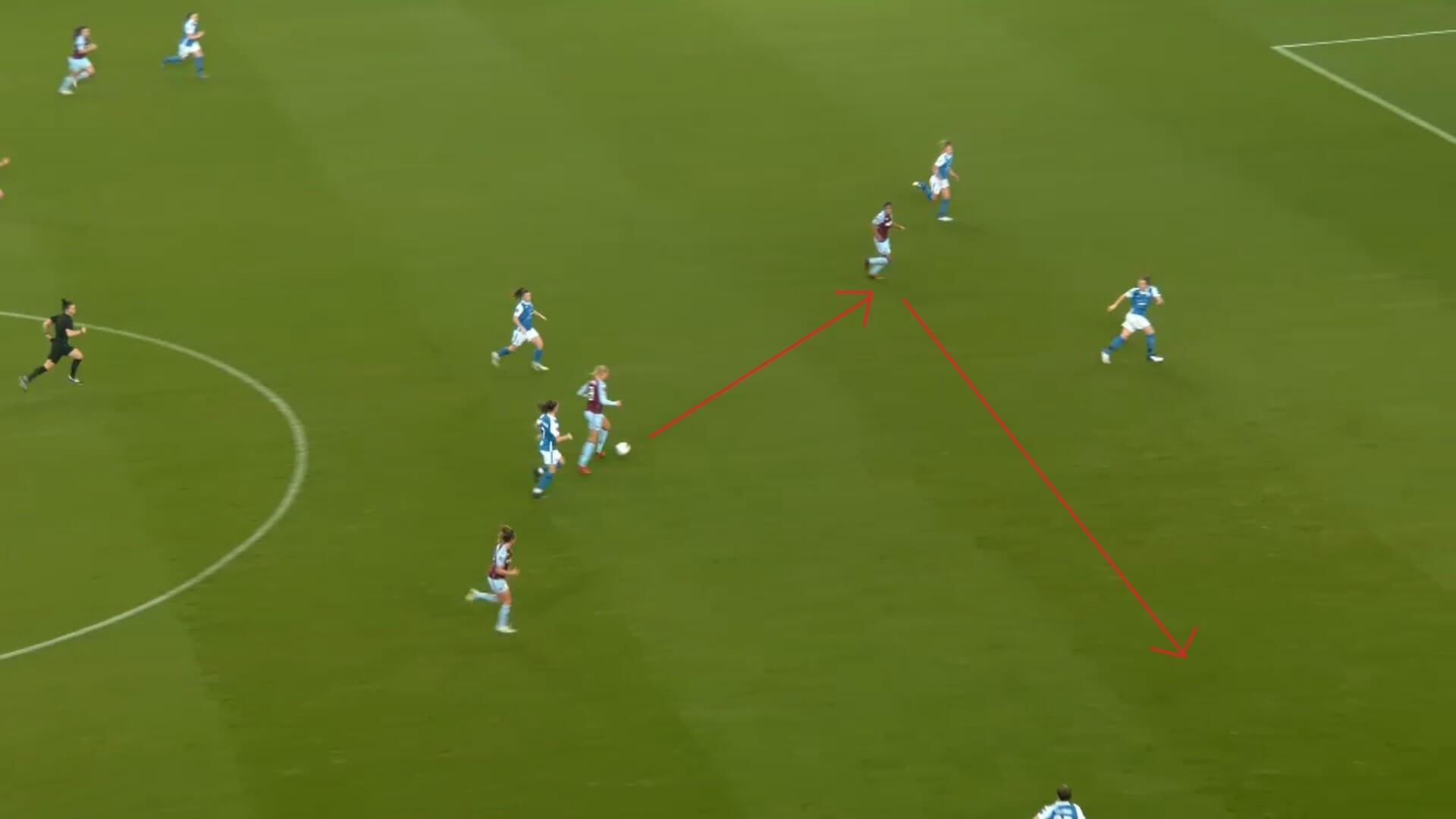
Something we have said about Aston Villa a lot this season is that they constantly get into good positions, but then can’t make the final pass count, or can’t get the ball into the right area. This image shows how this was true against Birmingham City Women too. We can see how the ball has been passed to Shania Hayles, who was playing as the central attacker in the forward line, and Aston Villa’s tactics usually see them get runners either side of the central striker to offer passing options. Here, when Hayles gets the ball, she then passes to the right-hand side, as the red arrows show. However, the pass ends up going to the Birmingham defence, because there are no Villa attackers ready to receive the ball there. This is what Aston Villa need to address because it is the reason they are not breaking defences down when they have the players to do it.
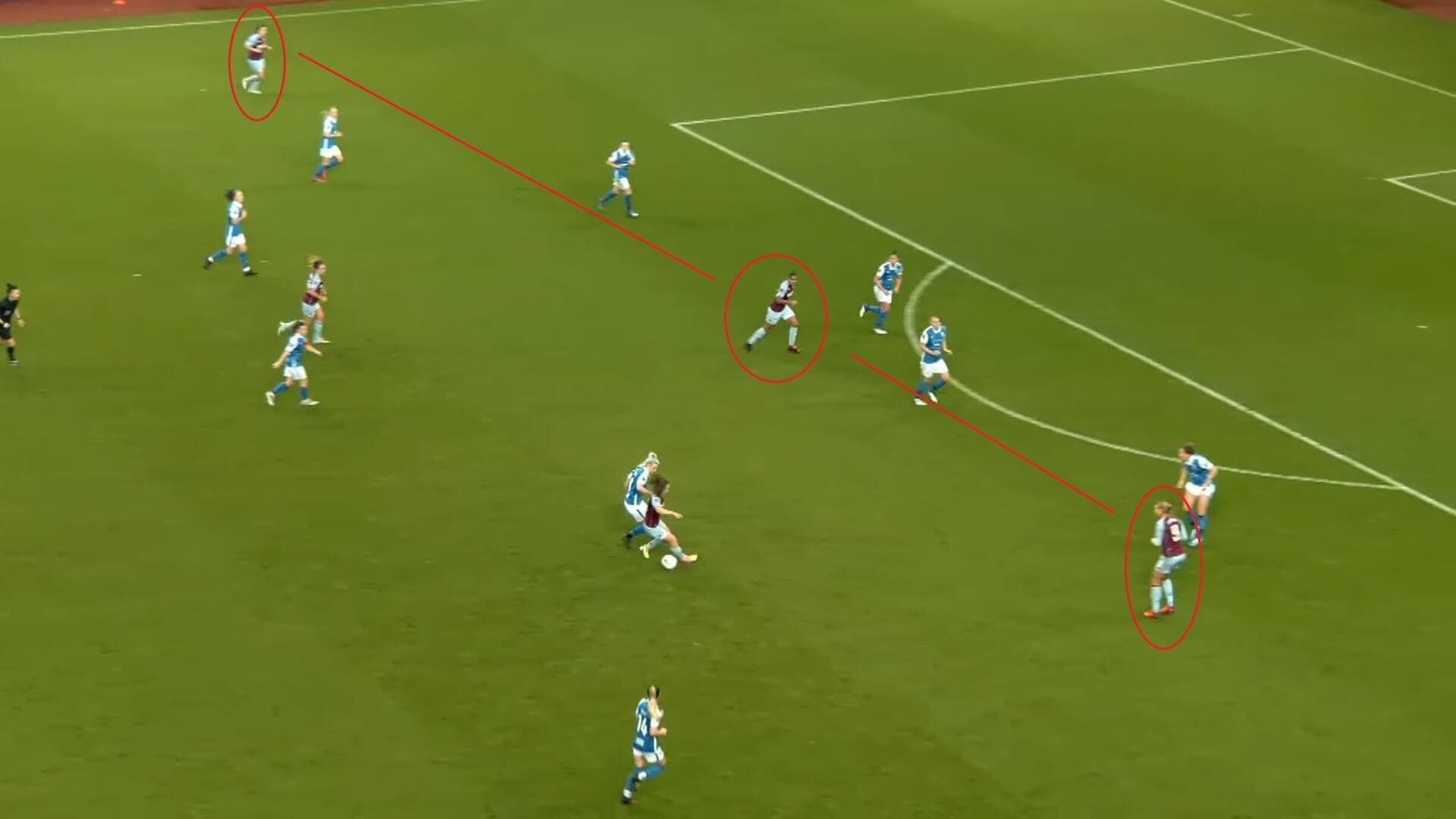
This is not to say, however, that their setup was wrong. If we look at this image, taken from the early stages of the game, we can see how they looked to play in the usual way, spreading the forward line across the pitch and using the width to get around Birmingham’s narrow defence. This was something that continued in the second half, too, as we can see below.
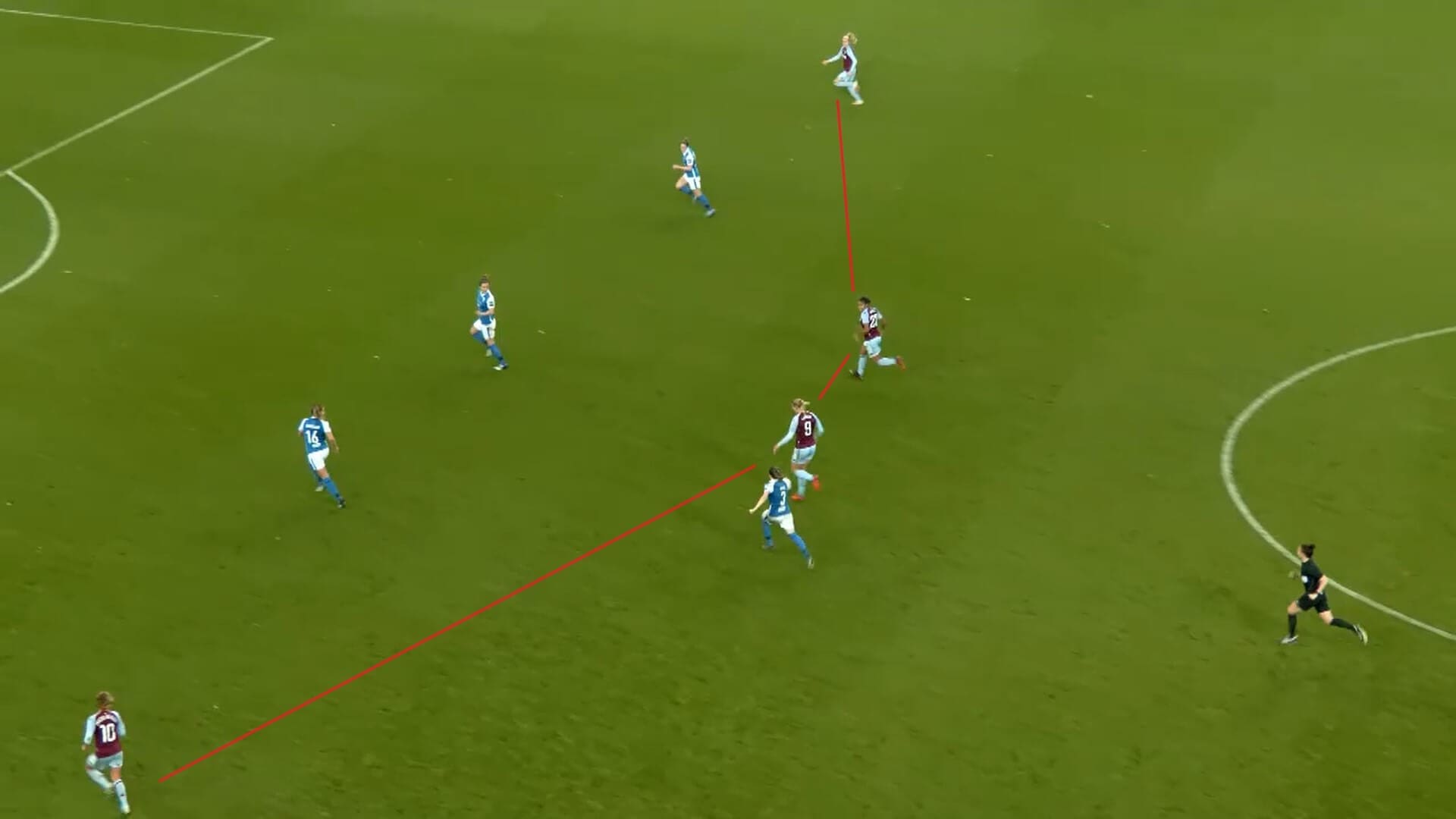
Here, they have two central attackers in Shania Hayles and Stine Larsen, whilst German midfielder Ramona Petzelberger is operating as the left winger in this situation.
What these two images indicate is that Aston Villa’s tactics for getting the ball around opposing defences, particularly those as narrow as Birmingham’s in these two images, are good, and allow them to control the width when on the attack. However, what lets them down is the final pass, as the first image in this section showed, and that is the reason that they have struggled to score goals so far, only netting three times in their opening five games.
Birmingham City Women’s defence
However, Birmingham City Women also made life difficult for Aston Villa Women in attack, as we knew they would.
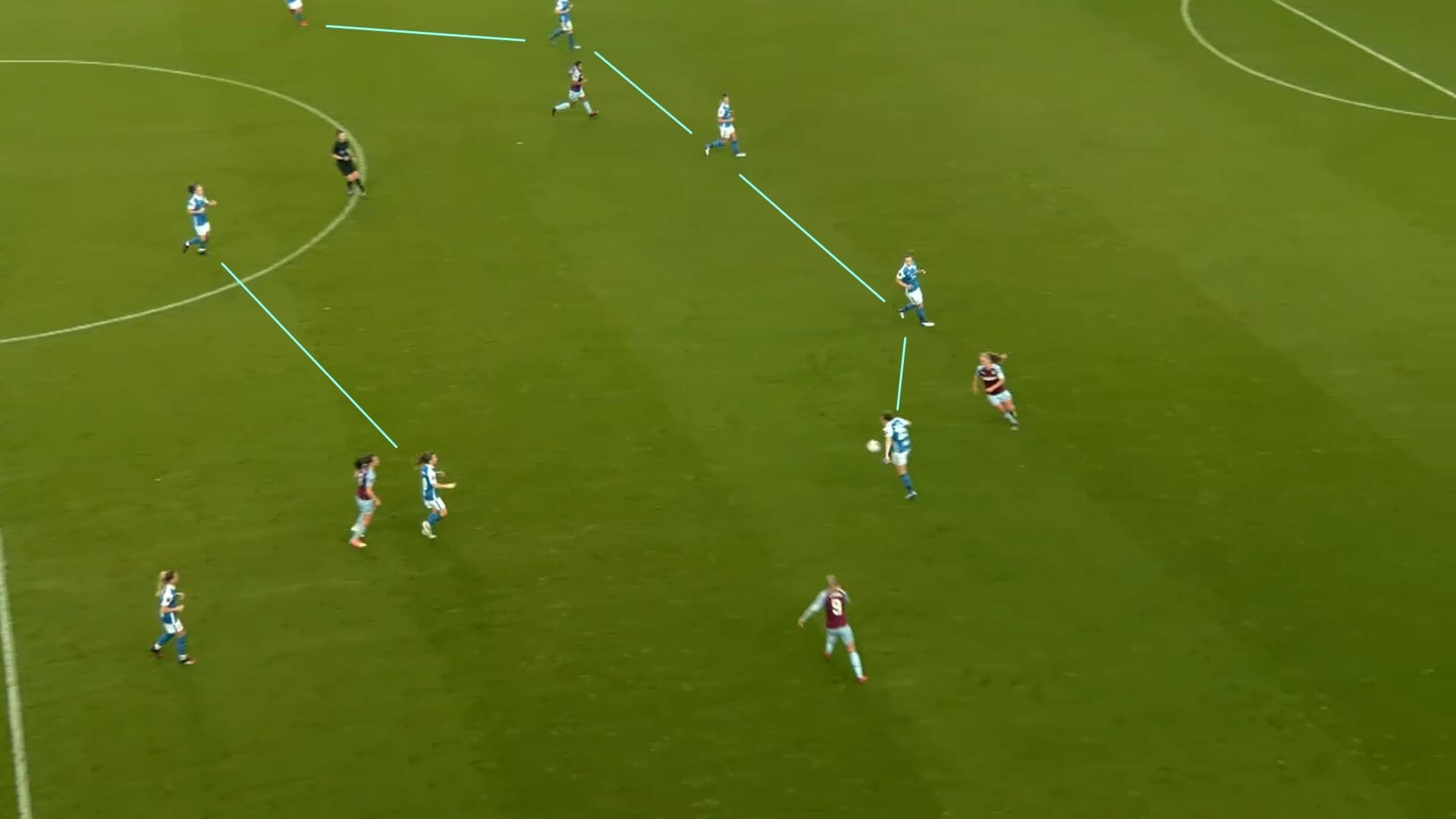
Here, we can see how Birmingham are organised, with every player knowing their roles in the system. This is something manager Carla Ward has really worked on since joining this summer, and we saw a setup like this in their game against Chelsea Women earlier this season, which meant that the defending champions struggled to break Birmingham down. Here, Aston Villa have looked to get the ball behind Birmingham’s defence, but it is now in the possession of Birmingham left-back Rebecca Holloway. From this position, she can clear it, ending the danger.
If we look at the defensive structure shown in the image, we can see just how difficult it makes Birmingham to break down. There is little space between the defence and midfield, meaning any pass through has to be made with pinpoint accuracy, and this is why Birmingham have been tougher to beat this season.
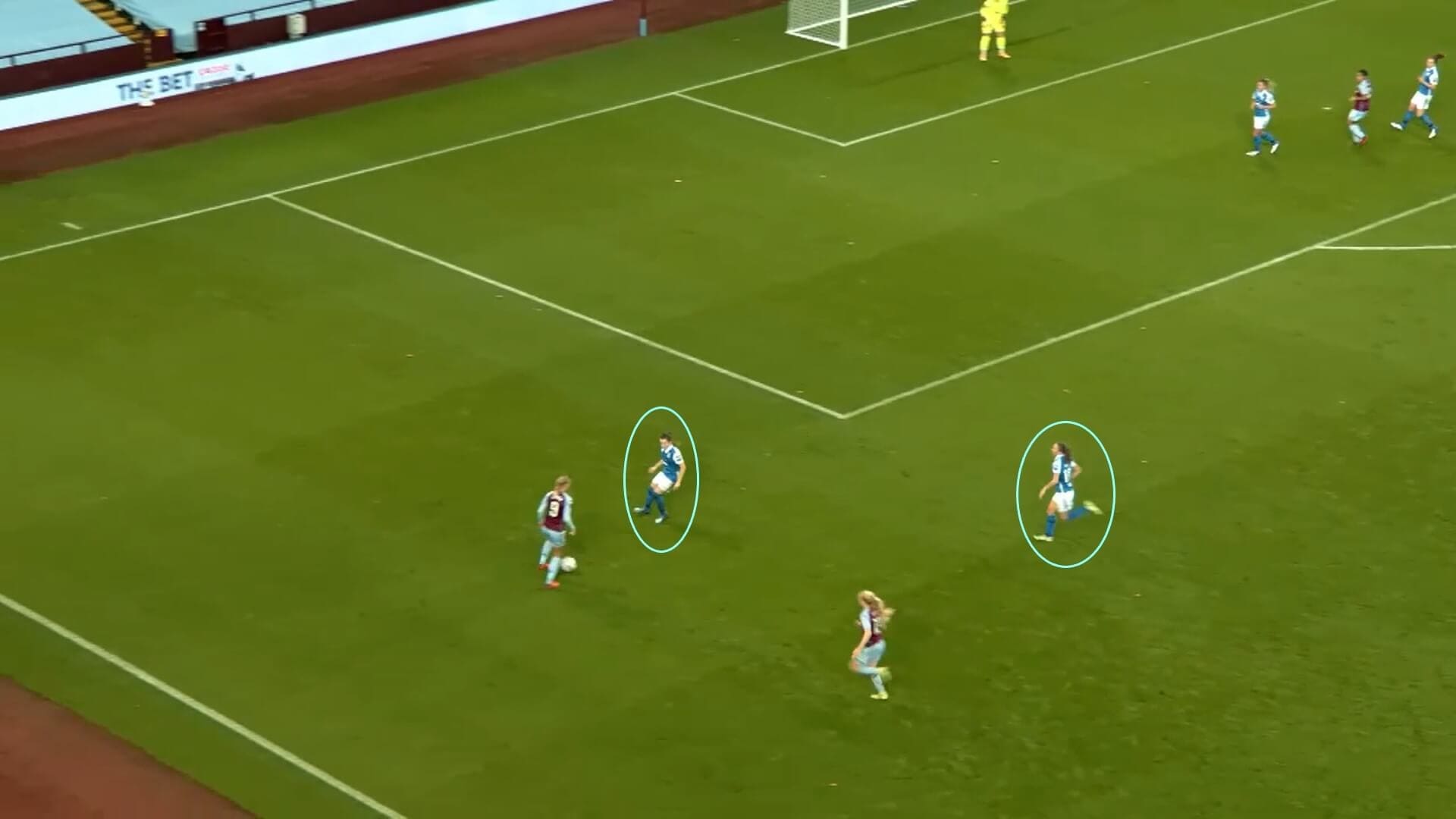
They also looked to close Villa’s players down, wherever they were on the pitch. In this image, in the second half, we can see how Stine Larsen has the ball for Villa on the left-hand side, but Birmingham have come across to stop her from making a cross into the box. By getting this tight to the Denmark international, Birmingham force her to pass back across the line, therefore ending the danger.
The other thing that makes this work is that Birmingham like to hunt in packs when defending like this, and two defenders have come across here to stop the ball being crossed into the box. This means that there is one player closing down the ball, and another who covers the space behind, ensuring that Larsen can’t find a way past the first defender into that space.

This is another example of Birmingham hunting in packs. Again, Villa are in attack, but can’t find a way into the box. The ball is in the central channel, but there are five defenders all moving towards it, taking time away from Marisa Ewers, wearing number 21 for Villa. This was happening all over the pitch, and it meant that Villa found it very hard to get an equaliser once Birmingham had scored the only goal of the game.
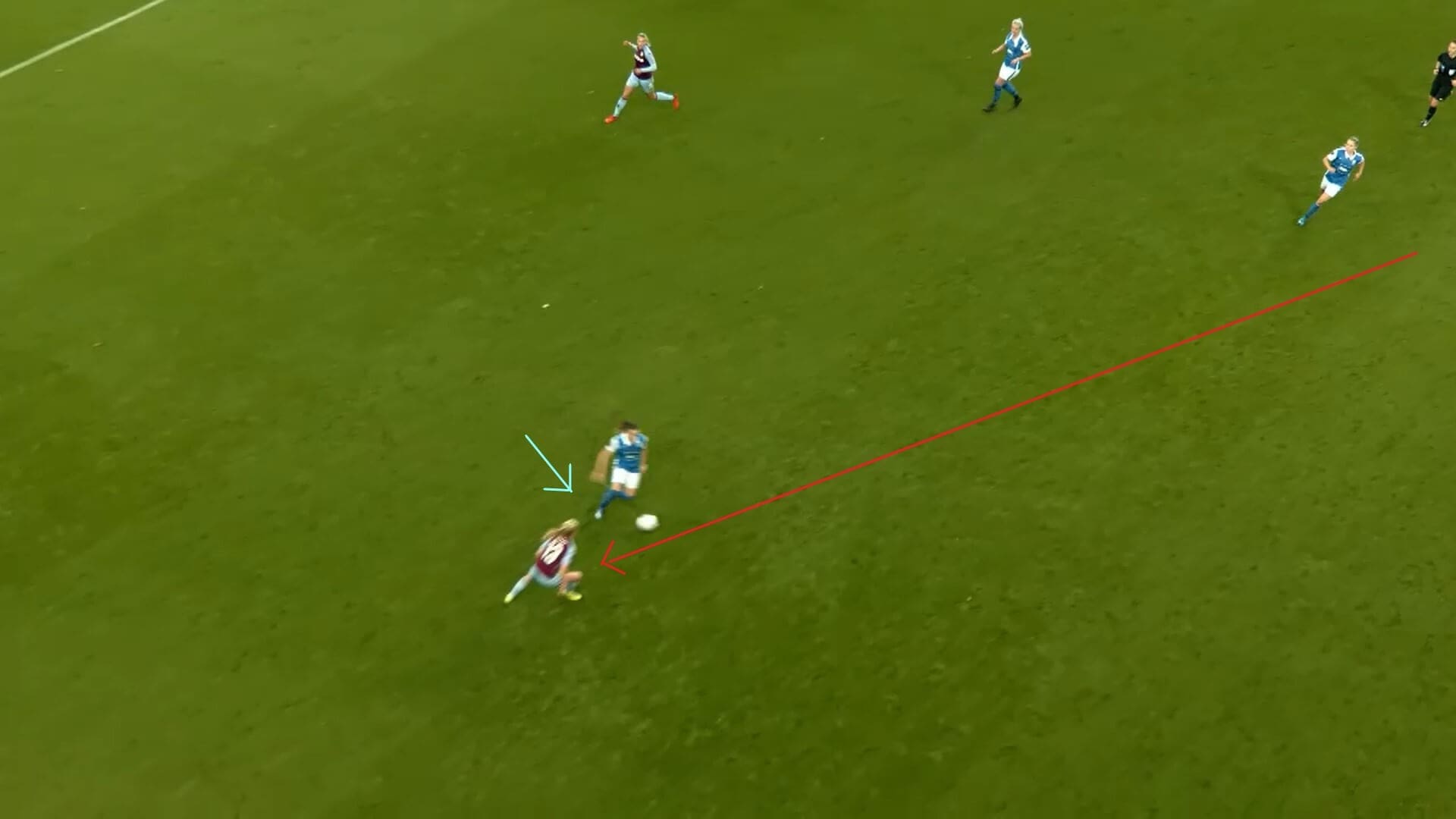
Birmingham defended very passively in the first half, allowing Aston Villa to have the ball and giving them too much space with it. However, in the second half, they were on the front foot much more, closing Villa down, as has already been analysed, and intercepting passes, as we can see in this image. Here, Villa have looked to play the ball out towards the wing, looking to find a way into the box, but the pass has been intercepted by the Birmingham defender, who can then clear it up the pitch.
This section has shown how Birmingham’s defence was a key reason why Aston Villa didn’t create many clear chances. It has also shown how their second-half changes helped them to be more aggressive in closing down Villa’s attacks, ensuring they could record a clean sheet and keep Villa out.
Mollie Green and Claudia Walker partnership
When it comes to Birmingham’s attack, their setup this season has seen Claudia Walker given a role at the top by herself. However, Mollie Green, who joined the club after leaving Manchester United Women this season, has taken a role as a supporting attacking midfielder, linking up with Walker a lot. This image shows how this works.
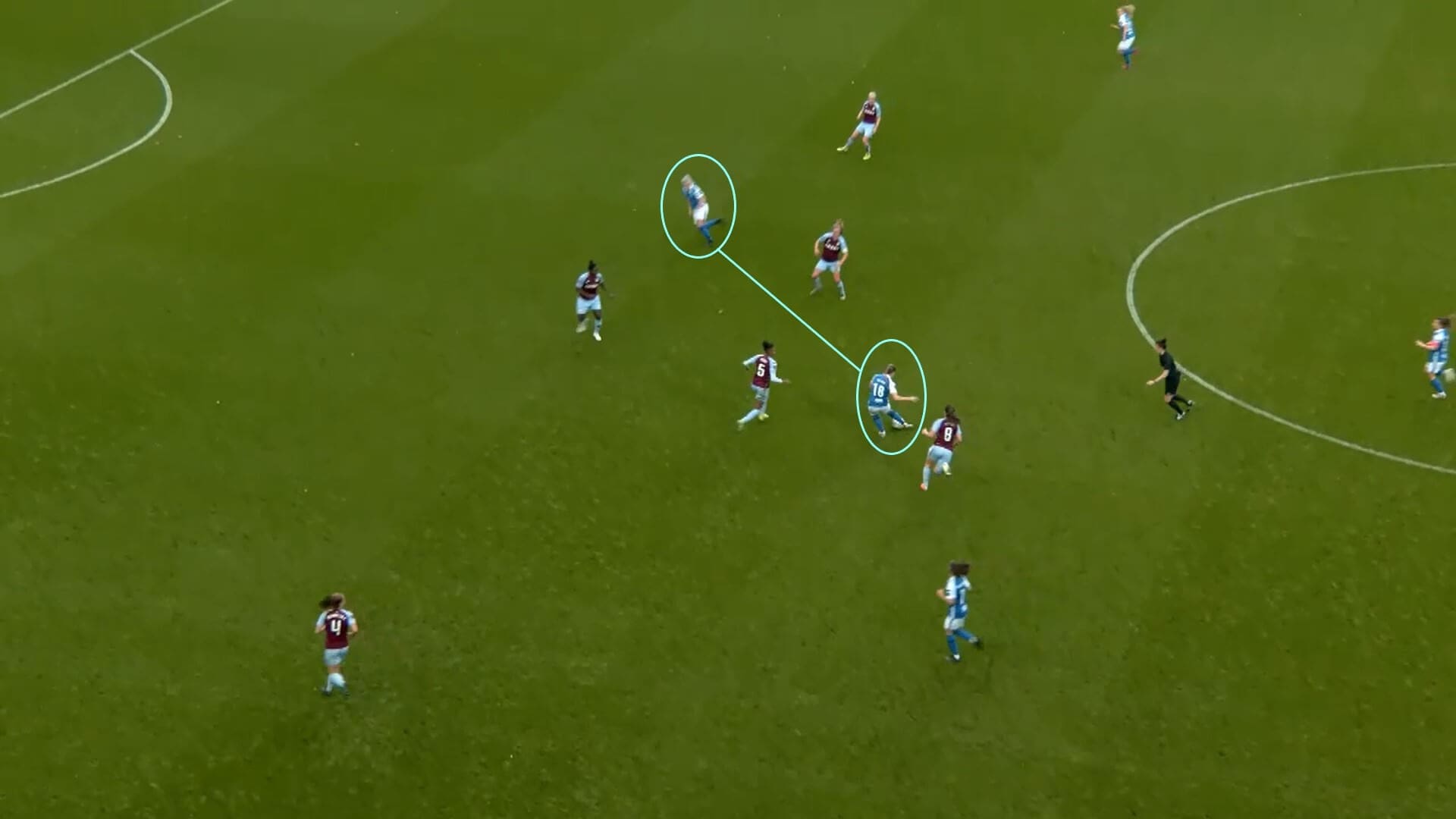
Here, Walker has drifted backwards towards the midfield to pick up the ball, and Green has moved forwards to offer the passing option behind the defence. Therefore, we see how they work together to ensure that, even though Walker is on her own upfront, she has support from the players behind her. This is crucial, particularly when you consider how, in this image, Aston Villa Women haven’t left much space available between them. Therefore, if Green hadn’t made the run through, then it is likely that Walker would not have been able to dribble the ball through the Villa defenders.
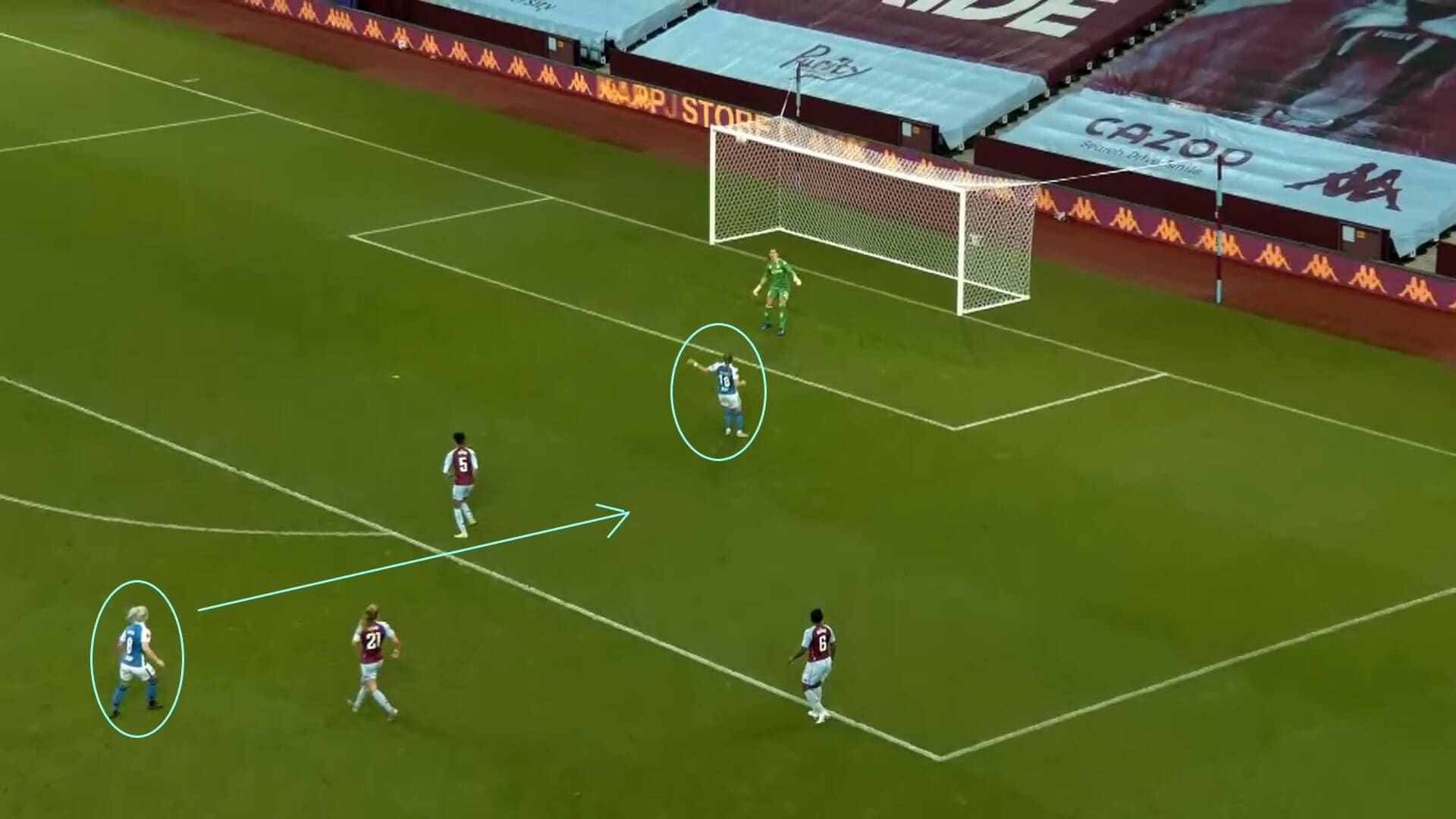
Here, in the second half, we can again see how Walker has taken a shot at goal, which has been saved by Villa’s experienced Germany goalkeeper Lisa Weiss. However, Green is in her usual advanced position, and this enables her to run forward and meet the rebound in the box, as the blue arrow shows. Therefore, her partnership with Walker enables her to get into the right positions to support her teammate. In this instance, Green’s shot went wide of goal, but it still shows how these two players working together helps Birmingham to create openings in opposing defences, as well as creating plenty of chances in opposing thirds.
Birmingham City Women’s attacking changes
We have looked at the way Mollie Green and Claudia Walker link up together to help their team create chances, but Birmingham City Women’s overall first-half attack was too passive. Aston Villa Women have conceded 12 goals already this season, and we know that they are not the strongest team defensively. Therefore, Birmingham could have been braver in attack than they were.
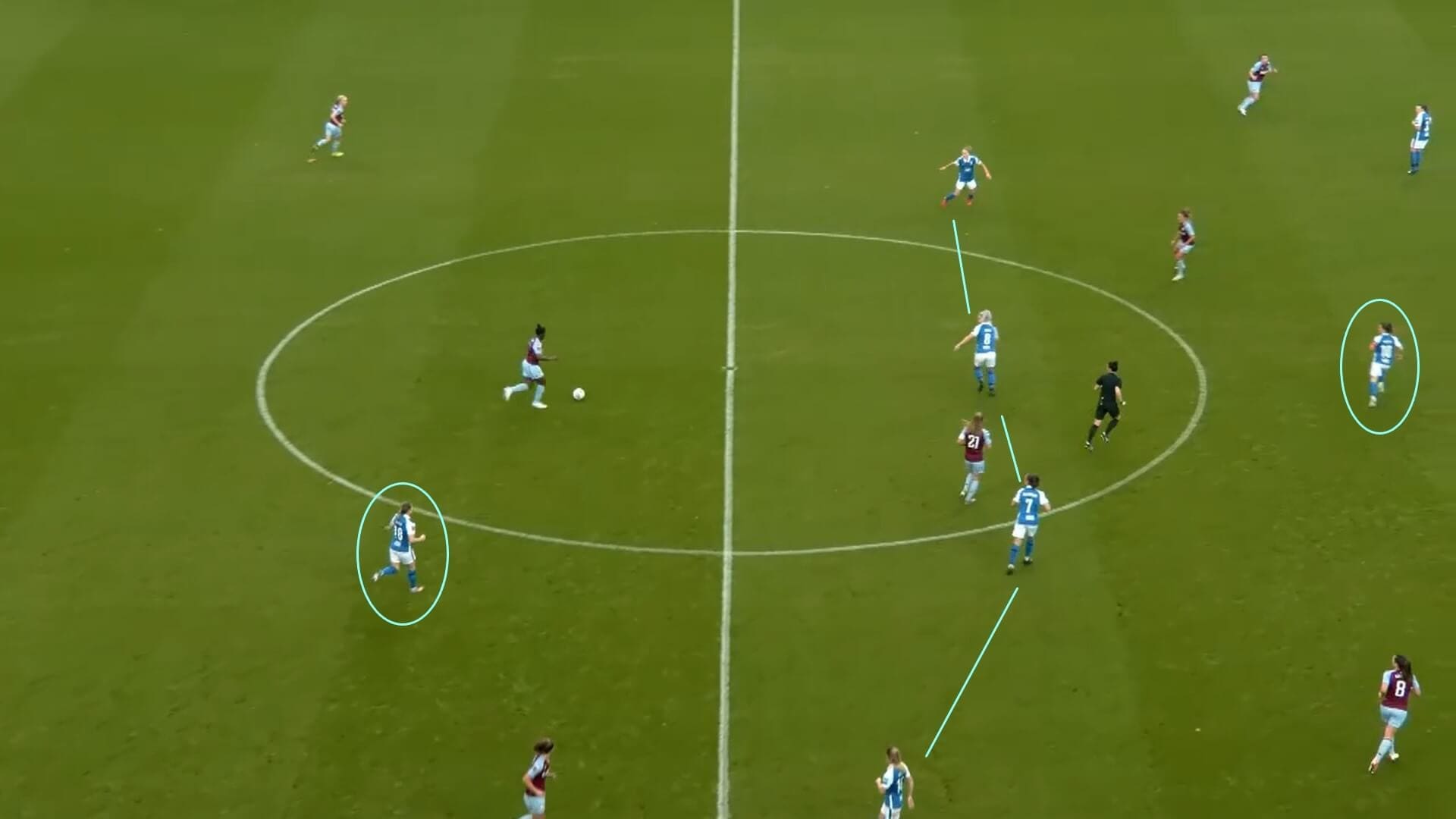
Here, we see how Birmingham like to set up under Carla Ward, in a 4-1-4-1 formation. This allows them to have a strong defence and midfield, as well as allowing captain and former Liverpool Women midfielder Christie Murray to float around between the two, whilst Claudia Walker leads the line. However, whilst it makes them harder to break down, and allows them to transfer the ball through the thirds from defence to attack, it doesn’t allow for much support for Walker, aside from Mollie Green, who we have already looked at.
This can be a problem for Walker, as she often has to face the whole opposing defence on her own.
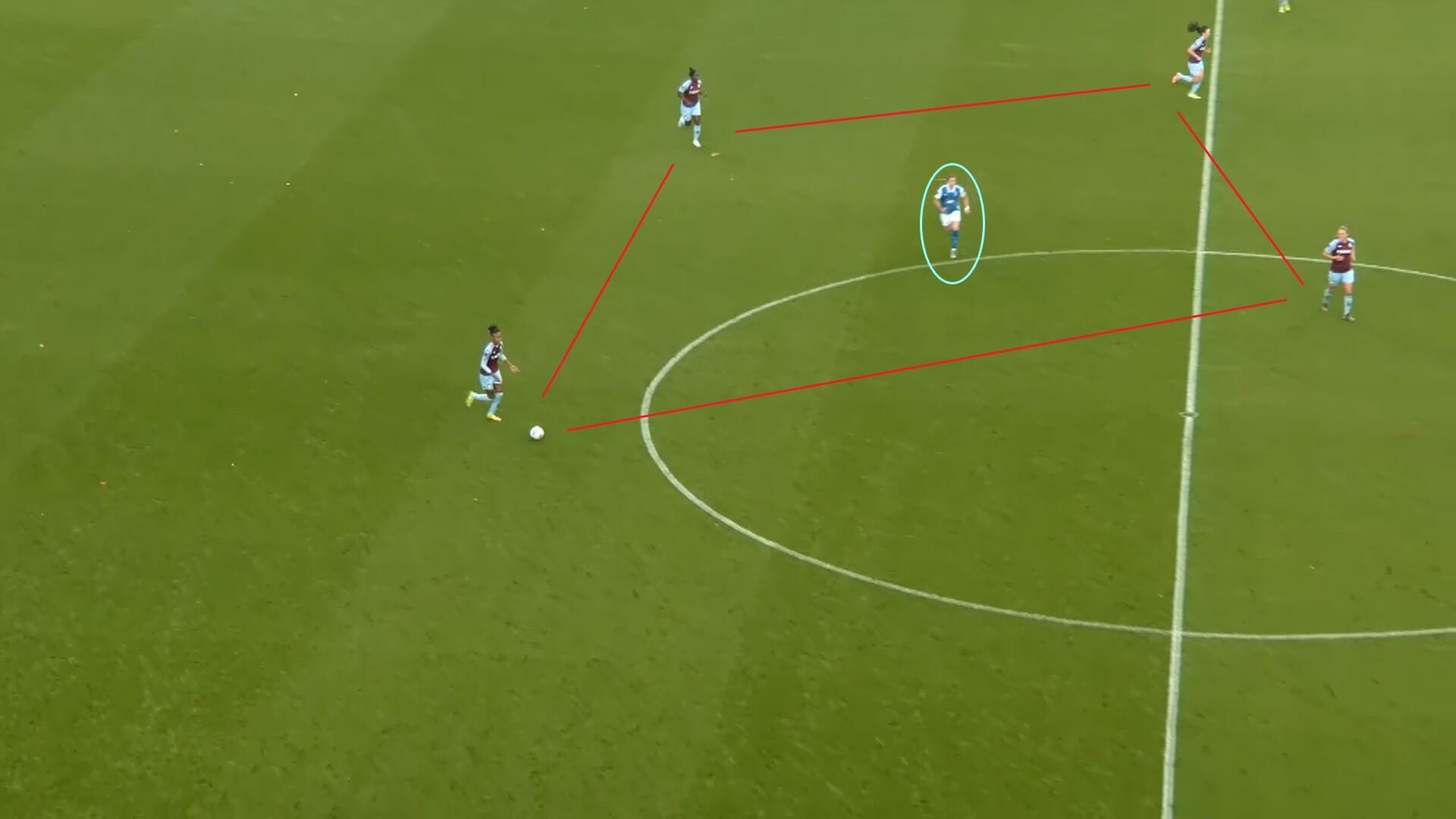
Here, we can see the effect of this. Aston Villa have formed a square structure around her, ensuring that they can move the ball around her and up the pitch. Therefore, what was clear was that, as with their defending, Birmingham were too passive in the first half, and could have done with being a bit braver, taking time away from Aston Villa. This would have put the pressure on Villa to move the ball much quicker, which could have led to them making mistakes with their passing.
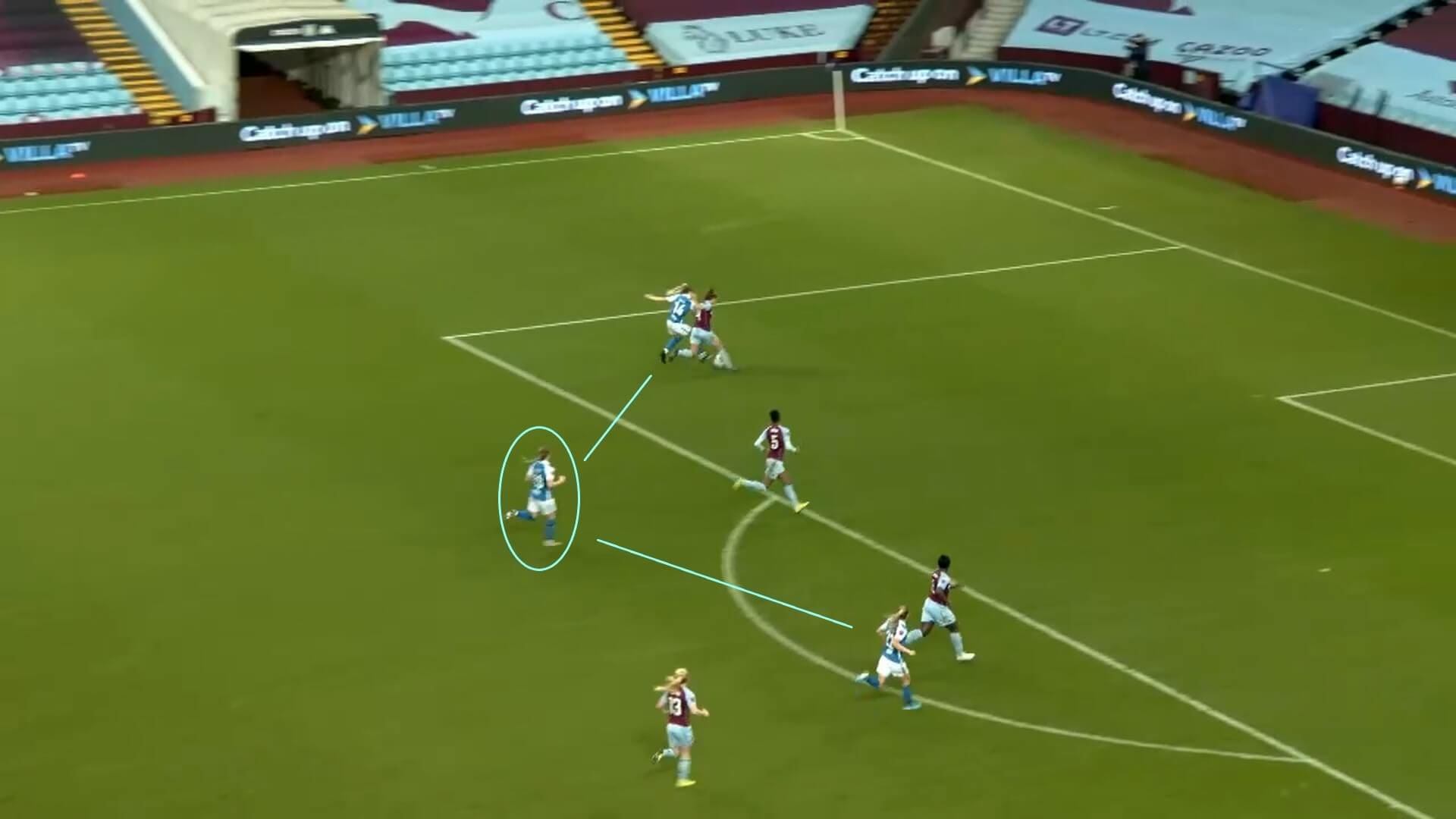
As you can see in the image above, Birmingham got more players forward in the second half, supporting Walker. It was Connie Scofield and Emma Kelly who got the furthest forward, making a front three structure, and this caused Aston Villa more problems in defence. As the image shows, they closed Villa down much more, forcing them to be more careful in possession, and that stopped Villa playing around Walker, taking their numerical advantage in their half away.
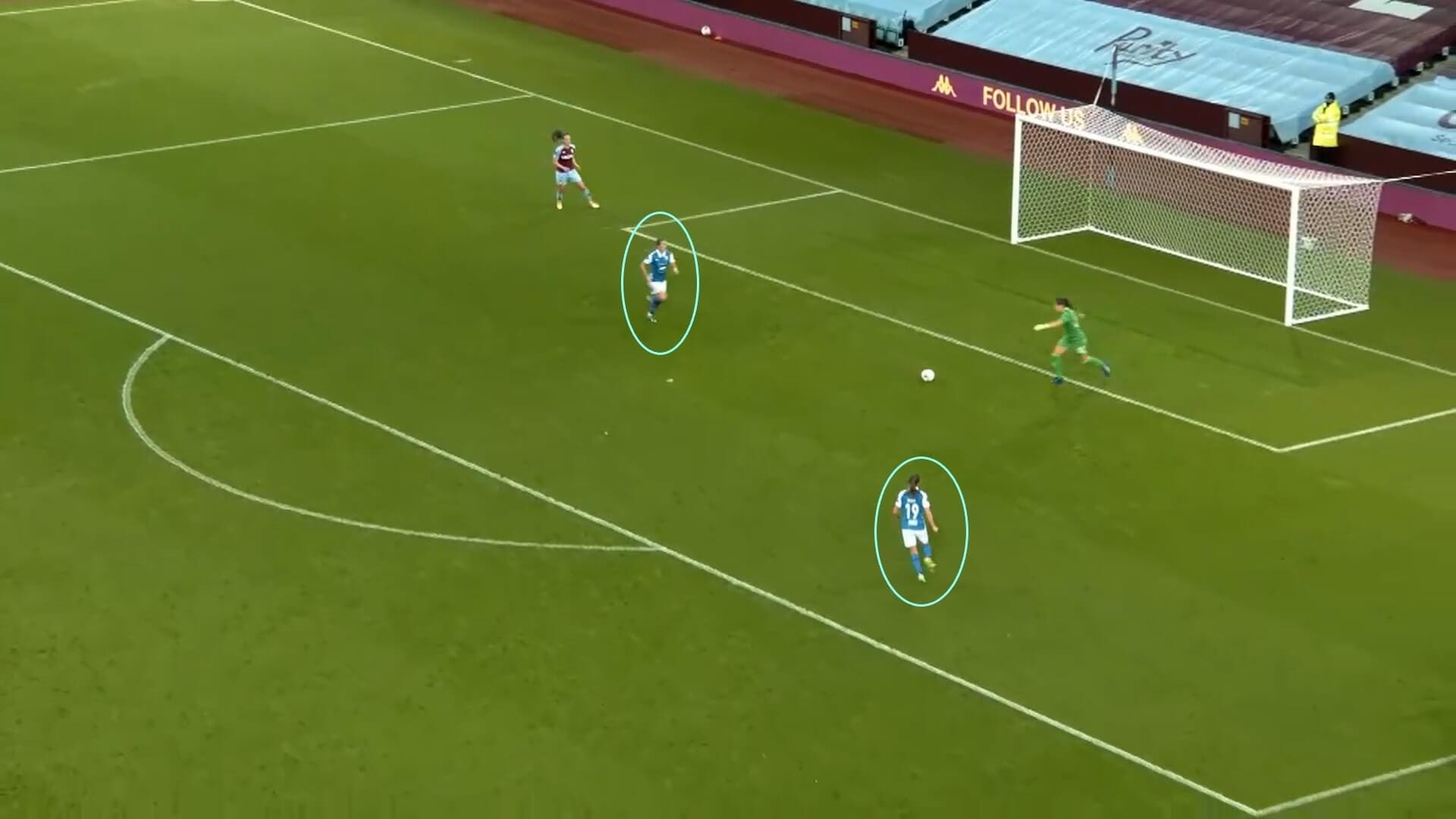
However, there was another thing that Carla Ward did that helped Birmingham to be more attacking in the second half. Lucy Whipp was part of the front four that started most games last season, along with Walker, Abbi Grant and Rachel Williams, who moved to Tottenham Hotspur Women over the summer. Whipp is a natural forward player, not a midfielder, so it was natural that, when she came on early in the second half, she would go on to form a front two with Walker, as we can see here. With both players in the final third, this took even more time away from Aston Villa, forcing them into making errors at the back, whilst also giving Birmingham two forwards on the pitch, meaning they carried more of a threat.
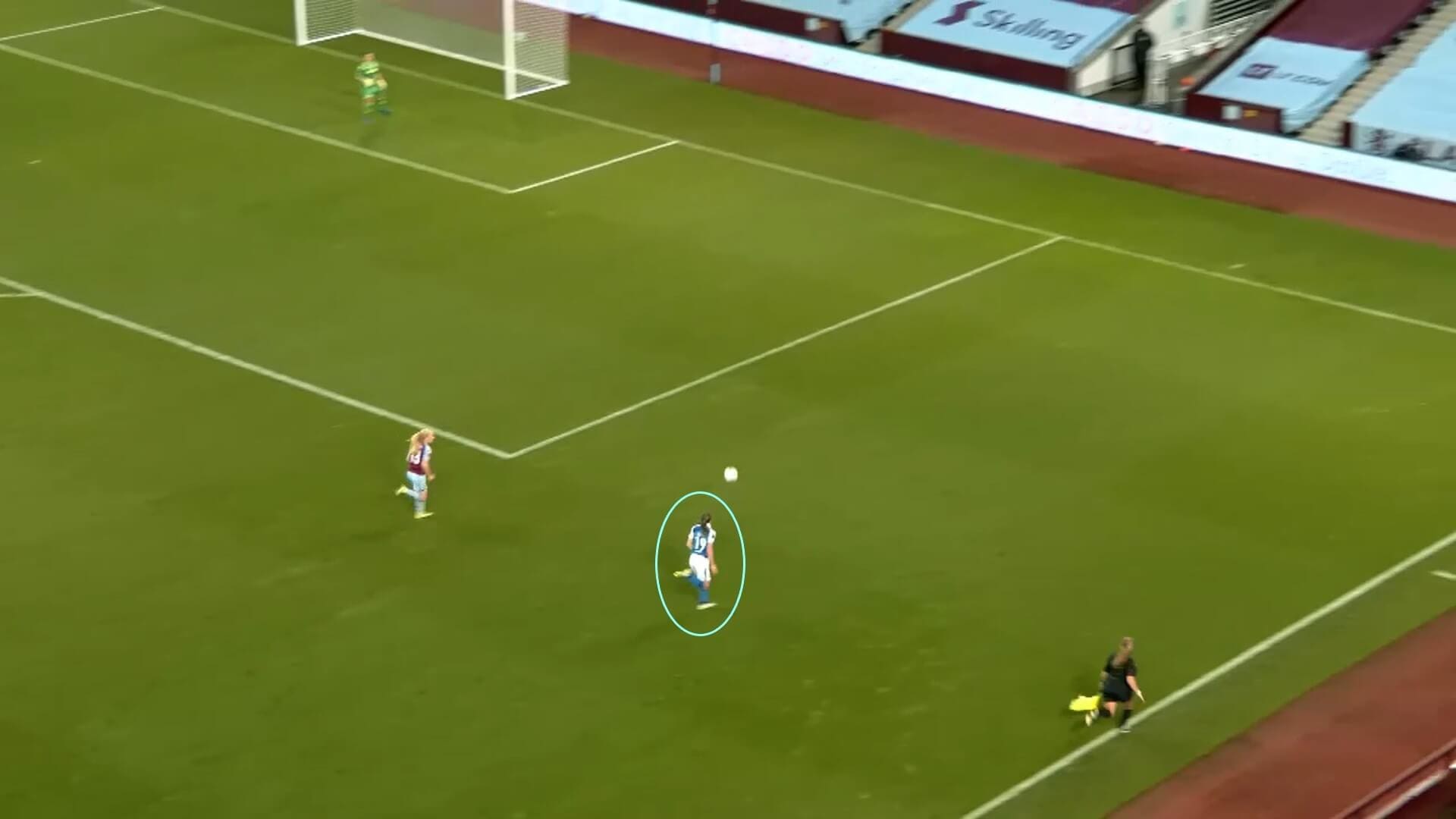
The other key part of Birmingham’s attacking tactics this season has been playing long balls over the top of opposing defences to Claudia Walker. This means that they often catch out opposing defences who don’t have enough players back to cover the spaces. However, in the first half, we didn’t see many of these, and it meant that Villa only had to watch the ground passes through to Walker. With Whipp on the pitch, the away side started to play these long aerial passes much more, and it helped them to create more chances. The ball has come long here from on-loan Everton Women defender Georgia Brougham to Whipp, in the blue circle, and the forward’s subsequent cross into the box led to the only goal of the game from Walker.
Therefore, we can see how playing these long balls in the second half helped them to create more opportunities, meaning Birmingham posed more of a threat, and that was what led to their winning goal; Walker’s fifth goal in six games in all competitions, after not scoring at all last season. This statistic in itself highlights the changes Carla Ward has made to the team since her summer appointment.
Conclusion
In conclusion, we have seen in this analysis how Aston Villa Women set up in a way that allowed them to cause Birmingham City Women problems in attack. Still, Birmingham changed their defensive tactics to help them take control of the game in the second half. The away side also didn’t pose much of a threat in the first half in attack, but made changes there to help them be more creative and have more chance of scoring a goal. Ultimately, Birmingham will be happier, not just because they won, but also because their changes worked, whilst Aston Villa will know they need to make the final pass work when they are in good positions; otherwise, they will continue to struggle to turn good chances into crucial goals.
The WSL now takes a break until 5 December, when Aston Villa will host unbeaten league leaders Manchester United Women. Meanwhile, Birmingham will be on the road again, as they face the team in second place in the league, Arsenal Women.




Comments